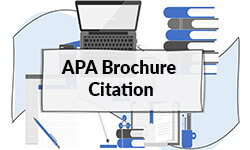
Properly citing sources is crucial in academic and professional writing. Not only does it help readers find the original sources of information, but it also prevents plagiarism and establishes the credibility of your work. The APA format is widely used in psychology, education, and social sciences. However, it can be tricky to cite brochures correctly since they are not traditional academic sources. This article focuses on the guidelines of brochure citations in APA style.
Definition: APA brochure citation
Brochures are informational pamphlets or booklets that often present data, guidelines, or promotional material in a condensed form. These can be helpful in academic writing. However, because they are not traditional scholarly publications like journal articles or academic books, they have a specific citation format within the APA style. An APA brochure citation refers to the bibliographic reference for a brochure using the APA style, typically included in the APA references section at the end of your academic paper.
Format for in-text citation and reference entry
In academic writing, in-text citations and reference entries are crucial for attributing credit to the authors of the works you have consulted, thereby upholding the principles of academic integrity. Thus, the format of an APA brochure citation will be illustrated in the following.
In-text citation
When you refer to the brochure in your text, an in-text citation should be included. The general format for an APA in-text citation is:
- (Author’s Last Name, Year of Publication)
If the APA brochure citation has no author, use a shortened version of the title.
Reference entry
In the reference list, the citation should include full details about the brochure. The format is:
- Author’s Last Name, First Initial. (Year). Title of brochure [Brochure]. Publisher.
If no author or publisher is available for the APA brochure citation, the title moves to the author position, and “n.p.” (no publisher) is used for the publisher spot.
APA brochure citation example
FAQs
If no date is available, use the abbreviation “n.d.” (no date) in place of the year both in your in-text citations and reference entries. This indicates to the reader that the date of the publication is not available.
If the brochure is written by an organization or a corporation, you should use the name of the corporation as the author, both in your in-text citations and reference entries of the APA brochure citation.
No, according to APA style, the title of the brochure should be in sentence case and not italicized. Only the titles of longer works like books and journals should be italicized.
